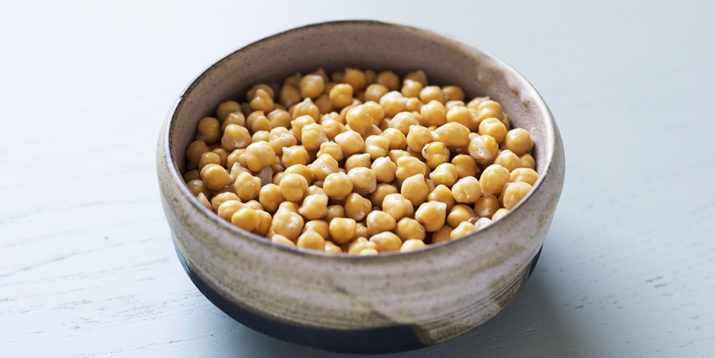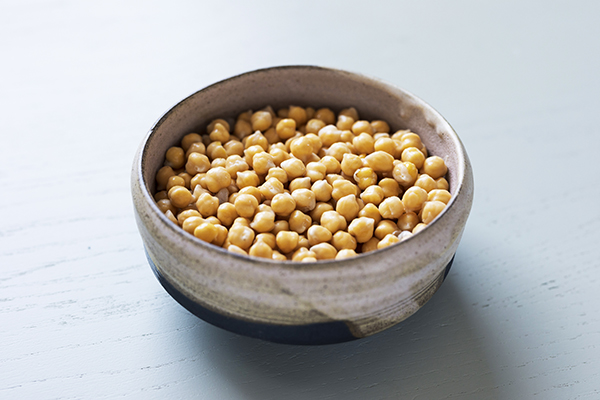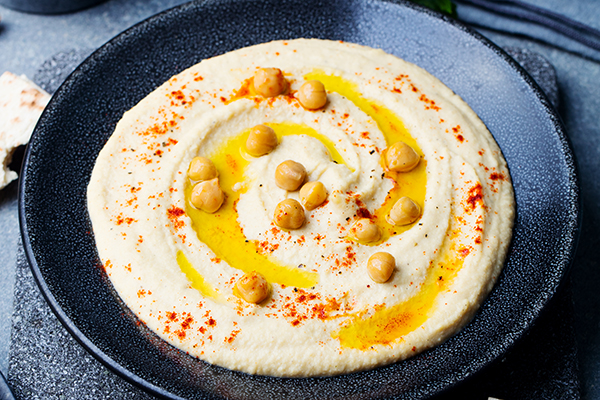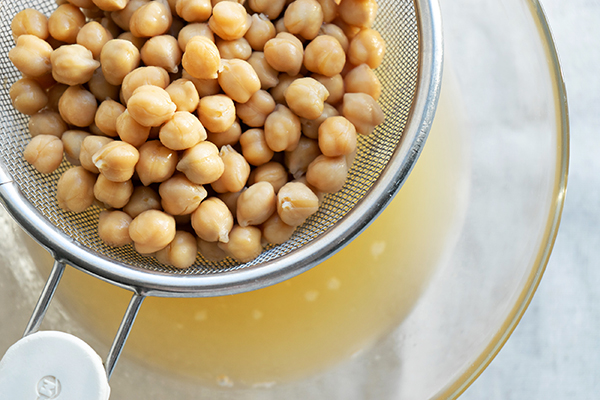Everything You Need to Know About Chickpeas

Chickpeas are having a moment. In fact, the global chickpea market is predicted to grow by $4.68 billion by 2024. (That’s a lotta hummus!)
Their popularity makes sense given their versatility.
Chickpeas can be tossed on salads, roasted for a crunchy snack, blended into baked goods, and of course — blended with tahini, olive oil, lemon juice, and spices to make hummus.
With a creamy texture and mild flavor, you can add chickpeas to just about any cuisine and eat them any time of day.
Want to learn more about this humble, beloved legume?
Read on for chickpea nutrition facts plus creative ways to use them in sweet and savory dishes.

What Are Chickpeas?
As one of the most commonly consumed legumes and most popular vegetarian foods, chickpeas have become a staple in pantries and refrigerators around the globe.
Their name comes from the Latin word cicer, and they were one of the earliest cultivated crops.
They were first grown in Mesopotamia up to 7,500 years ago. There are two classifications of chickpeas: Kabuli and Desi.
Kabuli, also known as garbanzo beans, are the larger of the two and have a lighter, cream color.
The smaller, darker Desi chickpeas range from tan to black. You’re more likely to find Kabuli chickpeas in U.S. grocery stores.
Chickpea Nutrition Facts
Here are the chickpea nutrition facts for one cup of these cooked legumes:
- 269 calories
- 15 grams of protein
- 4 grams of fat
- 45 grams of carbohydrates
- 13 grams of fiber
Chickpeas also provide lysine, an essential amino acid that the human body can’t make on its own.
“Lysine is limited in most plant foods other than legumes,” says Taylor Wolfram, M.S., R.D.N., L.D.N., a vegan registered dietitian with a private practice based in Chicago.
Vegans should eat a varied diet to ensure adequate intake of all nutrients and minerals.
Here’s another fun chickpea nutrition fact: They can often be enjoyed by people with common dietary restrictions.
“They’re gluten-free, vegetarian, vegan, and allergen-friendly,” says Danielle Gaffen, M.S., R.D.N., L.D.

Chickpea Benefits
Sure, the chickpea nutrition facts prove they are a healthy, plant-based food — but they also have some pretty impressive benefits beyond fiber and protein.
“Blended chickpeas can add creaminess to anything, such as dips and soups,” Wolfram says.
- Use them to thicken soups and stews.
- Blend into smoothies for plant-based protein.
- Puree them into sauces in place of cream!
More Chickpea Nutrition Facts
Chickpea pasta nutrition
If you’ve taken a stroll down the pasta aisle, you’ve likely seen all sorts of alternative noodles, including ones made from chickpeas.
“Chickpea pasta is loaded with protein and fiber and is naturally gluten-free,” Wolfram says. “For anyone looking to add more protein to their pasta meal, it’s a great choice.”
Chickpea flour nutrition
The almighty chickpea doesn’t stop there; you can also find it in the baking aisle.
“Chickpea flour has a fine texture and a nutty, earthy flavor,” Gaffen says. Plus, per cup, you get 21 grams of protein and 10 grams of fiber!
Chickpea Liquid, a.k.a., Aquafaba
When you open a can of chickpeas, do you pour off the liquid? Save it!
While this often discarded ingredient — known as aquafaba — won’t add loads of nutrients to your diet, it can pull off some serious culinary wizardry.
“Aquafaba is a great vegan way to add foam or body to various recipes such as meringues, macarons, and homemade plant-based mayo,” Wolfram says. “It’s a really neat way to use everything in the can!”
While Gaffen says baked goods using aquafaba don’t always brown as deeply as recipes using an egg, the texture of the final product is often pretty close to the real deal.

How to Cook Chickpeas
If you plan to cook dried chickpeas, it’s a good idea to soak them first.
“This not only speeds up cooking time but also makes them easier to digest,” Wolfram says.
Bring them to a boil for 10 minutes, then simmer until tender. Skim off any foam, but keep the cooking liquid!
One of the most convenient ways to cook chickpeas? Buy them canned.
They’re already cooked and ready to eat, but you can roast them in oil and spices to change up their texture and add flavor.
If you are trying to be more conscious of added salt, remember to get chickpeas that have no salt added or that say “low sodium” on the can.
“Rinse and drain a can of chickpeas, dry them on a clean dish towel, add to a mixing bowl, and drizzle with avocado or grapeseed oil and your favorite seasonings. Spread evenly on a baking sheet and bake at 400 degrees Fahrenheit for 15 to 20 minutes,” Wolfram recommends.
To easily remove chickpea skins, Gaffen suggests rinsing and then pouring them onto a clean kitchen towel.
“Gently but vigorously rub the towel against the chickpeas until the skins loosen and fall off,” she says. This step makes your hummus extra fluffy and creamy.
Looking to expand your chickpea horizons? Try our vegan slow cooker stew with chickpeas and spinach or our maple chai-roasted chickpeas.
